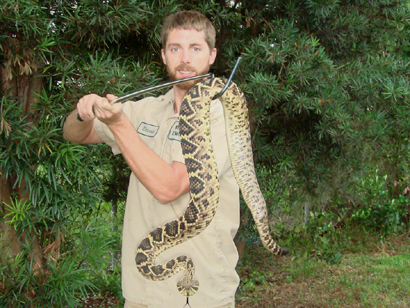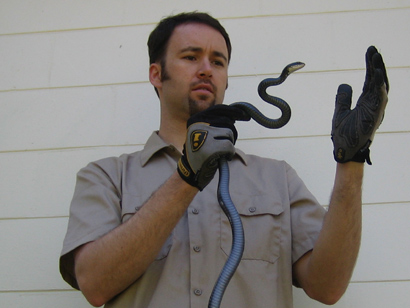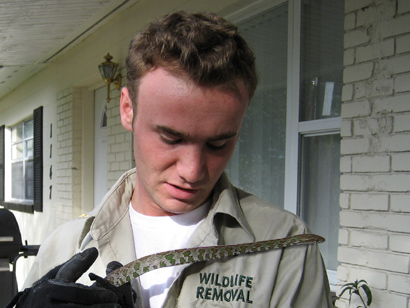- Snake Removal - Information about the humane trapping and removal of snakes.
Snake Removal
COMMON PROBLEMS: Snakes are often spotted in the suburbs and less urbanized neighborhoods. Many snakes live in a general range larger than your property, and might just be passing through. As stated, most are harmless. However, we get many snake calls in which homeowners or propety owners request snake control, for the following reasons:
- Fear of snakes, and a snake was seen somewhere on the property.
- Concerns about a snake believed to be venomous, and the danger it poses to people and pets.
- Snakes known to be living under a porch, shed, or any other area of a property.
- A snake stuck in an area such a swimming pool, screened-in porch, etc.
- A snake found inside the home (this happens fairly often).
- Snakes in the attic. Yes, this happens, usually rat snakes in search of food.
- A heavy population of snakes on a property, for which you wish to lower the numbers.
HOW WE CONTROL SNAKES: It depends on the situation. Here are some examples:
- Snake in the home - we arrive at the house as soon as possible, and remove the snake, either with gloves or a snake grabber tool. We place it in a snake sack, and take it away. We can also inspect the house to find out how it got inside, and seal the entry hole shut.
- Snake in the yard - we arrive as soon as possible, and remove it. What if we arrive on the property and the snake has moved on, and we simply can't find it? No problem! We simply set some effective snake traps on the property, and then return to remove the snake once it's caught.
- Snake prevention - this is difficult. Although some scam-artist snake prevention products are sold (usually mothball flakes, or cinnamon or some other BS), these products do not affect snake behavior. The only real prevention techniques are to eliminate denning areas, clear clutter and debris, or install a snake fence around the perimeter of an area. We can also set many snake traps, which will catch snakes. But except for a fence, you can never keep them away.
MYTHS ABOUT SNAKES: Snakes are misunderstood. Many people have an uncontrollable fear of snakes. Most of all, with so many snake species, people are simply uninformed about them. Here are some myths:
- IF IT HAS A TRIANGULAR HEAD, IT IS VENOMOUS: Almost all snakes have triangular heads. In fact, of the few that don't, one is the venomous Coral Snake. It is true that many pit vipers, like rattlesnakes and copperheads do have a very skinny neck in relation to a very broad head. But the triangular anectdote is worthless.
- IF IT HAS A PATTERN, IT IS DANGEROUS: Most snakes have patterns of some sort - stripes, rings, checkered patterns, etc. Very few snakes are a single solid color.
- SNAKES ARE AGRESSIVE, AND LIKE TO BITE: Heck no. Snakebites are very rare, and 97% of all snakebites occur when people pick up or otherwise directly mess with snakes. Even a venomous rattlesnake would rather shake its tail when threatened then attempt a bite. Most snakes would rather run away from you. I've never seen a snake deliberately approach a person.
SNAKE TOOLS WE USE: In the vast majority of cases, the snake is non-venomous, so we simply pick the snake up. Snakes usually only bite when picked up, so we wear gloves. But here are some other tools we need from time to time:
- Snake Tongs, or Snake Hook - If the snake is venomous, no one should handle it by hand. We use a pair of gentle snake tongs, or a hook that scoops up the snake, and we transport it to a snake bag that way.
- Snake Bag - This is a good way to safely hold and transport a snake for relocation. Beware, a heat-sensing pit viper can still strike through a bag.
- Snake Traps - We'd rather not set traps, but they work, and if we can't find a hiding snake in your house or lawn when we arrive, we set the snake traps, and return once the reptile is captured.
- Snake Repellents: Although they are marketed and sold, they simply don't work. The reason somne repellents get good online reviews is because snake sightings are rare, and when a repellent is applied after one is seen, it probably wasn't going to be spotted again anyway. I have this tiger whistle which is great at keeping tigers out of my backyard too.
Repellents and Home remedies to get rid of snakes - The most common home remedy for snake removal is mothballs. Please do not fall for this trick. Mothballs were originally developed to be used against moths and other cloth-eating insects. The ingredients used to make the substance are a combination of deodorants and fumigants. Mothballs work—against moths. Not only do snakes not use the sense of smell for the same reason people do, mothballs has no remarkable impact on the reptiles. Other home repellents include citrus sprays, sulfur bombs, peppermint oil, and rope barriers. Avoid anything that is an odorant. They just don't work. The rope barrier goes back to the days when cowboys feared snakes curling up with them at night. Supposedly, a rope is too prickly for a snake to slither across. This is just as false as the mothball statements. Snakes are wild animals and are equipped to travel over rocks, sticks, gravel, and bracken. There is nothing about a rope that will keep snakes away. The only effective do-it-yourself snake remedy is modifying your yard to be unappealing to snakes. Keep your grass short and your gardens maintained. Do not leave any piles of debris in the lawn. If a snake can hide under it, it will.
Learn more in my educational articles. I have articles on many topics related to snakes that you will find useful when handling your critter problem. Find out how big snakes get and what to do if you find a shed snake skin. I also have advice on how to find and remove a snake from your attic, and where you should relocate a trapped snake. Find out if snakes come out in the rain, learn how snakes kill their prey, and how to get snakes out from under a shed or porch. Learn the difference between a Venomous snake and poisonous snake, and my view on whether you should hire a pro, or remove snakes yourself.
I also have articles about specific species of snakes, including Black Rat Snakes: Climbing Constrictors and Pygmy Rattlesnakes: Small, Still Dangerous. You can also learn about the problem of Burmese Pythons in south Florida.
If you want to do it yourself, read my How To Get Rid of Snakes page.
If you want to identify snake feces, see my Snake Droppings page.
If you want to identify a Copperhead Snake, see my Copperhead Snake page.
To learn more about snake repellent products, read my Snake Repellent page.
Learn how to get snakes out from under a house or Snakes In Basement.
Snake in Your House - Tips on how to get a snake out of hour house.
Learn how to identify a snake on my How to Identify a Snake page.
Snake Prevention - Preventative methods for how to keep snakes away from your property.
Snake Under a Shed or Deck - Sometimes snakes will live under or a shed or deck.
How To Trap a Snake - Methods for catching snakes in cage traps.
Snake in the Attic - Info about what to do if you have snake in the attic.
How to Kill a Snake - Does poison work to kill snakes? Is killing snakes the best approach?
Learn more about snakes through my educational articles. Learn how snakes sleep, how they smell their environment, how they produce venom, and what equipment or tool is needed to catch a snake. Find out if snakes run out of venom, and about Water Moccasins: Poisonous Predators. Learn why snakes bite, and how snake venom works. Read about how to kill a snake in the yard, and about the biology of the Yellow Rat Snakes. Find out what to do if you get bitten by a snake, what might attract snakes, and how to keep snakes away from your property. Learn about the Banded Water Snake and find out if snakes eat birds. Find out if snakes always inject venom when they bite. Learn if snakes blink, as well as about the Black Racer Snake and Brown Water Snake.
Read what you should do with a snake after catching it and if a snake will chase you or climb trees. Learn how snakes communicate. Learn about the beautiful but deadly Coral Snakes and Corn Snakes. Learn about the Deadliest Snake in the United States and if Mothballs help repel snakes. Find out if a pest control company will remove a snake and how you can use a trap to capture a snake. Learn if snakes can dig holes, if they hibernate, and if it is safe to handle a snake with bare hands. Learn about the flexible foragers, Garter Snakes, and how to keep snakes out of your garden. Read what to do if you find a Snake's Nest and what is a snake fence. Read about how snakes feed their young babies and what snake feces look like. Learn what to do if a snake gets inside your house, and what snakes snakes eat, their natural diet, and if snakes drink water. Learn if a High Pitch Sound Deterrent Machine will work against snakes, and if snakes make good pets.
Learn if snakes feel pain, about the Northern Water Snakes and Diamondback Rattlesnakes: Patient Predators. Learn if the city or county animal services will help you with a snake issue, and if snakes can jump. Learn what animals catch and kill snakes and if it is legal for you to catch a venomous snake. Learn where snakes live and if they live in holes. Learn about the snake mating habits, how snakes move, if they come out at night, and if a snake under a shed or porch have a nest of babies.
Find out more about the Common Snakes across the country:
Common Snakes of Arizona Common Snakes of South Carolina
Common Snakes of Texas
Common Snakes of Virginia
Common Snakes of California
Common Snakes of Illinois
Common Snakes of Georgia
Common Snakes of Florida
Common Snakes of Pennsylvania
Common Snakes of Ohio
Common Snakes of North Carolina
Learn, too, about the Venomous Snakes across the country:
Venomous Snakes of Texas
Venomous Snakes of California
Venomous Snakes of North Carolina
Venomous Snakes of Georgia
Venomous Snakes of Florida
North American Snake Biology and Information
All snakes are carnivorous reptiles or meat eaters and come from the same family as the lizard. They are different than lizards in that they have no eyelids or external ears. Most species of snakes are non-venomous, although there are those that believe that all snakes have some form of venom but they just do not have the fangs and the venom is very weak. The venom is used for killing the snake's prey while and the non-venomous snakes simply swallow their prey.
Biology - The body of the snake is usually made up of a skull, vertebrae and a column of ribs. The brain sits inside the skull. The jaws of the reptile are not attached so that the snake can open its mouth wide enough to swallow its prey. The vertebrae column has anywhere from two hundred to four hundred vertebrae that are attached to the ribs. This gives the snake the structure for muscles to be attached and allows for movement of the body. The skin is covered in scales which are used to grab the surface while moving. The skin will shed or molt giving the snake a new skin several times a year. Snakes use their smell and vibration sensitivity to find its food. The forked tongue actually collects particles in the air and this is used for smelling. Snakes feed on small mammals, birds, insects, and lizards. Most snakes will swallow the food then lay quiet for some time to allow for digestion.
Life Cycle and Reproduction - All snakes breed by internal fertilization and most will lay eggs and then leave them buried. Some snakes will keep their eggs inside of them until they are almost ready to hatch. Snakes usually breed from August into the fall where the female will keep the sperm until spring when she wakes up from her hibernation. The gestation period is about three and half months long with the eggs hatching in late August. Snakes will lay anywhere from three to ten eggs, and the babies are on their own once they are hatched. Most snakes only have a birthing every other year. Snakes will live about seven years depending on the predatory rate.
Snake Habitat - Since the movement of snakes is not dependent on legs of some sort, the snakes use what is called undulatory locomotion which means that snakes move in a wave like motion. The snakes can live in any area but will live where it is dark and cool and there is a lot of food. These reptiles hibernate in the winter and come out in the spring. Most snakes will stay within a twenty five acre area. They can make a home in junk piles, gardens, basements and attics, where there is plenty of prey to keep them full. Snakes will also burrow into the ground if there is not an adequate house around.
Diseases Snakes Can Spread - All snakes can carry parasites such as mites and ticks, but because they go through a molten period these do not stay for any length of time. They can also carry salmonella and ringworms which can lay dormant for a couple of years before passing it on to humans. Salmonella is a bacterium that is natural to the snake but one that can make humans very ill with vomiting and diarrhea.
Common Nuisance Complaints - Most snake complaints are that they can cause physical harm if they are venomous. Most snakes are more aggressive during mating season or right after the wake up from their winter slumber. In this case they are hungry and will be searching for food and will not back off if you run into a snake. A heavy infestation of snakes can affect your health as well as the value of your home. Depending on the snake they will live in and around a garden area and will burrow under the ground disturbing the root system.





